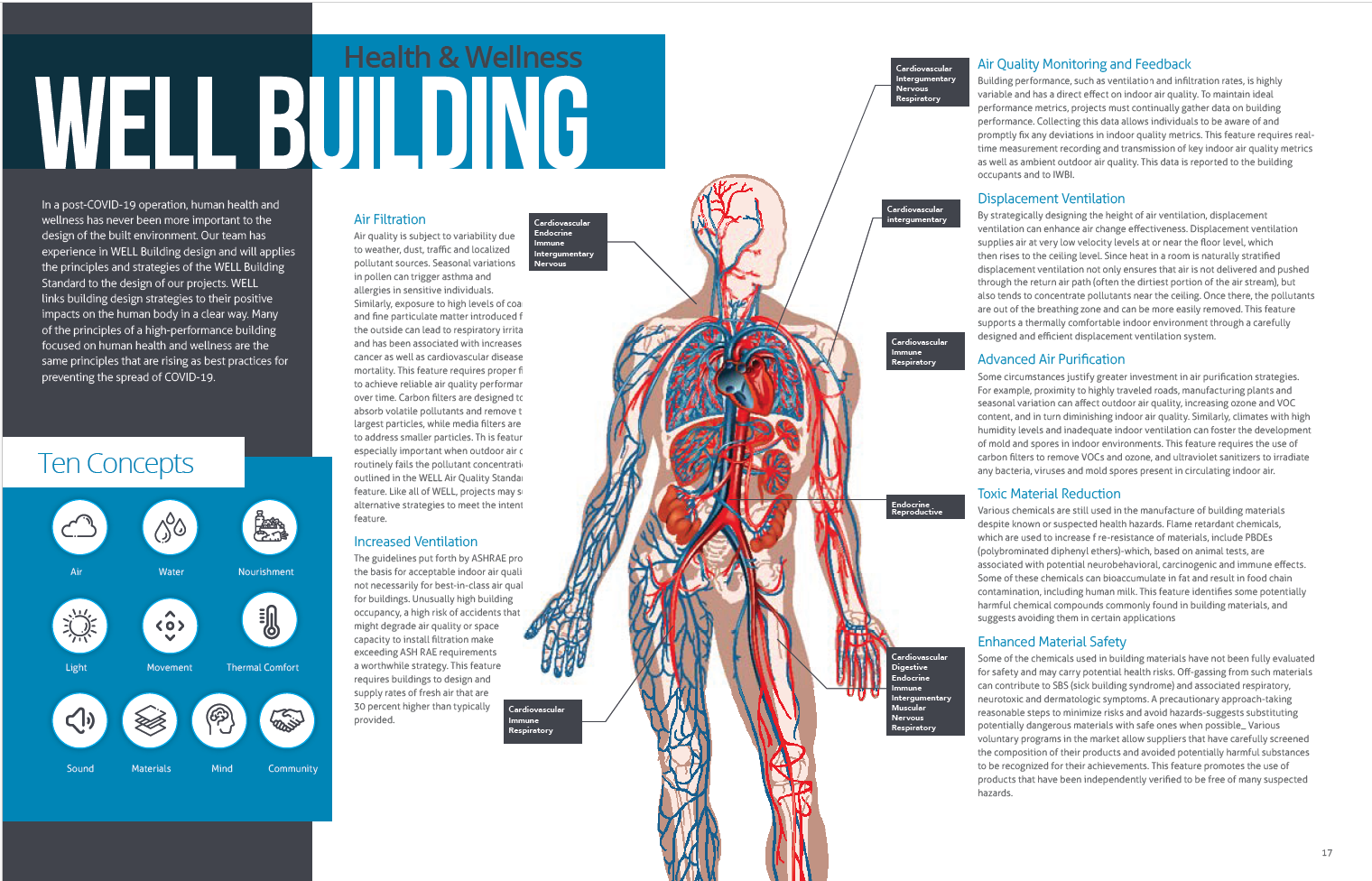Health + Wellness: WELL Building
Contents
Download PDFIn a post-COVID-19 operation, human health and wellness has never been more important to the design of the built environment. Our team has experience in WELL Building design and applies the principles and strategies of the WELL Building Standard to the design of our projects. WELL links building design strategies to their positive impacts on the human body in a clear way. Many of the principles of a high-performance building focused on human health and wellness are the same principles that are rising as best practices for preventing the spread of COVID-19.
Air Filtration
Air quality is subject to variability due to weather, dust, traffic and localized pollutant sources. Seasonal variations in pollen can trigger asthma and allergies in sensitive individuals. Similarly, exposure to high levels of coarse and fine particulate matter introduced from the outside can lead to respiratory irritation and has been associated with increases in lung cancer as well as cardiovascular disease and mortality. This feature requires proper filtration to achieve reliable air quality performance over time. Carbon filters are designed to absorb volatile pollutants and remove the largest particles, while media filters are meant to address smaller particles. This feature is especially important when outdoor air quality routinely fails the pollutant concentrations outlined in the WELL Air Quality Standards feature. Like all of WELL, projects may submit alternative strategies to meet the intent of this feature.
Increased Ventilation
The guidelines put forth by ASHRAE provide the basis for acceptable indoor air quality, but not necessarily for best-in-class air quality for buildings. Unusually high building occupancy, a high risk of accidents that might degrade air quality or space capacity to install filtration make exceeding ASHRAE requirements a worthwhile strategy. This feature requires buildings to design and supply rates of fresh air that are 30 percent higher than typically provided.
Air Quality Monitoring and Feedback
Building performance, such as ventilation and infiltration rates, is highly variable and has a direct effect on indoor air quality. To maintain ideal performance metrics, projects must continually gather data on building performance. Collecting this data allows individuals to be aware of and promptly fix any deviations in indoor quality metrics. This feature requires real-time measurement recording and transmission of key indoor air quality metrics as well as ambient outdoor air quality. This data is reported to the building occupants and to IWBI.
Displacement Ventilation
By strategically designing the height of air ventilation, displacement ventilation can enhance air change effectiveness. Displacement ventilation supplies air at very low velocity levels at or near the floor level, which then rises to the ceiling level. Since heat in a room is naturally stratified, displacement ventilation not only ensures that air is not delivered and pushed through the return air path (often the dirtiest portion of the air stream), but also tends to concentrate pollutants near the ceiling. Once there, the pollutants are out of the breathing zone and can be more easily removed. This feature supports a thermally comfortable indoor environment through a carefully designed and efficient displacement ventilation system.
Advanced Air Purification
Some circumstances justify greater investment in air purification strategies. For example, proximity to highly traveled roads, manufacturing plants and seasonal variation can affect outdoor air quality, increasing ozone and VOC content, and in turn diminishing indoor air quality. Similarly, climates with high humidity levels and inadequate indoor ventilation can foster the development of mold and spores in indoor environments. This feature requires the use of carbon filters to remove VOCs and ozone, and ultraviolet sanitizers to eradicate any bacteria, viruses and mold spores present in circulating indoor air.
Toxic Material Reduction
Various chemicals are still used in the manufacture of building materials despite known or suspected health hazards. Flame retardant chemicals, which are used to increase fire-resistance of materials, include PBDEs (polybrominated diphenyl ethers)-that, based on animal tests, are associated with potential neurobehavioral, carcinogenic and immune effects. Some of these chemicals can bioaccumulate in fat and result in food chain contamination, including human milk. This feature identifies some potentially harmful chemical compounds commonly found in building materials and suggests avoiding them in certain applications
Enhanced Material Safety
Some of the chemicals used in building materials have not been fully evaluated for safety and may carry potential health risks. Off-gassing from such materials can contribute to SBS (sick building syndrome) and associated respiratory, neurotoxic and dermatologic symptoms. A precautionary approach; taking reasonable steps to minimize risks and avoid hazards, suggests substituting potentially dangerous materials with safe ones when possible. Various voluntary programs in the market allow suppliers that have carefully screened the composition of their products and avoided potentially harmful substances to be recognized for their achievements. This feature promotes the use of products that have been independently verified to be free of many suspected hazards.

